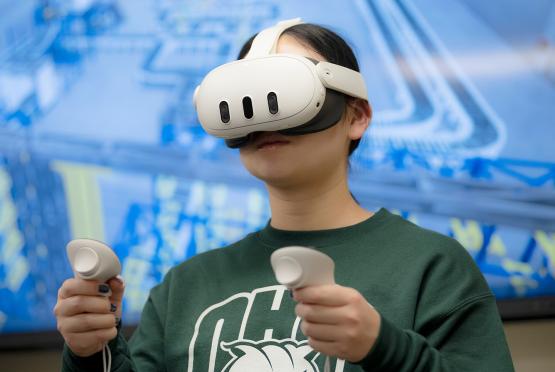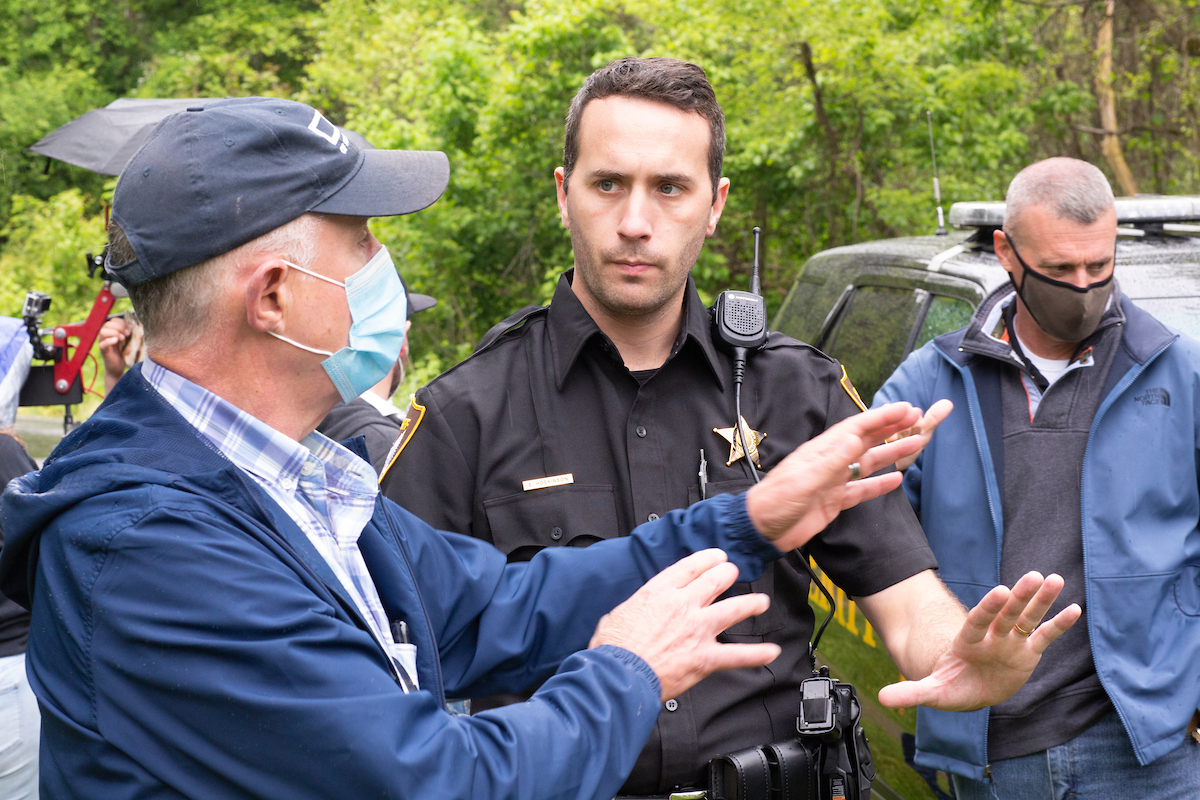
‘The sky’s the limit’: Using Cine-VR to revolutionize law enforcement training
An interdisciplinary team at Ohio University is harnessing an explosion in emerging technology to tackle one of the nation’s most pressing problems: How can law enforcement trainers expose officers to potentially flammable, on-the-spot situations, so they can learn de-escalation techniques? An innovative and highly technical solution is being unveiled in perhaps the unlikeliest of places – the wooded hills of Southeast Ohio.
Sarah Filipiak BSJ '01, BS '23 | December 15, 2023
Share:
“The integration of this technology is going to change law enforcement across the world, but certainly in the United States,” said John Born, visiting assistant professor, executive in residence at the Scripps College of Communication and the Voinovich School of Leadership and Public Service.
Born and other Ohio University faculty created OHIO 360, an award-winning Cine-VR program to provide immersive virtual reality training for law enforcement officers in Appalachia. Faculty members from Ohio University's Scripps College of Communication J. Warren McClure School of Emerging Communication Technologies (ECT), Eric R. Williams and John Bowditch, together with Born, are leading the project.
The virtual reality scenarios were scripted with input from law enforcement units across the region, Bowditch said. Bowditch is the director of the Game Research and Immersive Design (GRID) Lab, which works on tech-based projects from video games to virtual reality experiences of all kinds.
Williams, the author of two books on cine-VR, wrote and directed the scripts in collaboration with Athens Police Department auxiliary commander and forensic psychologist David Malawista.

Director Eric R. Williams, right, consults on set in front of the Athens County Courthouse. Photo by Ben Siegel
The scenarios are named for their principal characters, “Chet” and “Dion.” Chet is a veteran suffering a mental crisis because of post-traumatic stress disorder and Dion is a Black man who has recurring adverse encounters with law enforcement officers during what they believe are routine stops.
“Chet is really focusing on mental health and PTSD and maybe law enforcement officers not knowing the full story before they interact with someone that's suffering mental health challenges,” Bowditch said. Dion “is about racial biases...the impact [a series of run-ins with law enforcement] has on him, and how different officers don't see necessarily how that's compounding over time and creating a scenario that's not going to end well for anyone.”
Bowditch said the experiences of officers from the Ohio University Police Department, the Athens County Sheriff Department and the Athens Police Department informed the storylines for the training scenarios, which were then delivered to several police departments in Southeast Ohio.
The response confirmed this was training unlike any participants had experienced before, said Jay Johnson, assistant professor of practice and director of the George V. Voinovich Academy for Excellence in Public Service, located at Ohio University's Dublin Campus. "Everybody that takes off [the VR headset], the first word out of their mouth is 'Wow.' They think it’s going to be like ‘Avatar’, or a cartoon—it’s not."
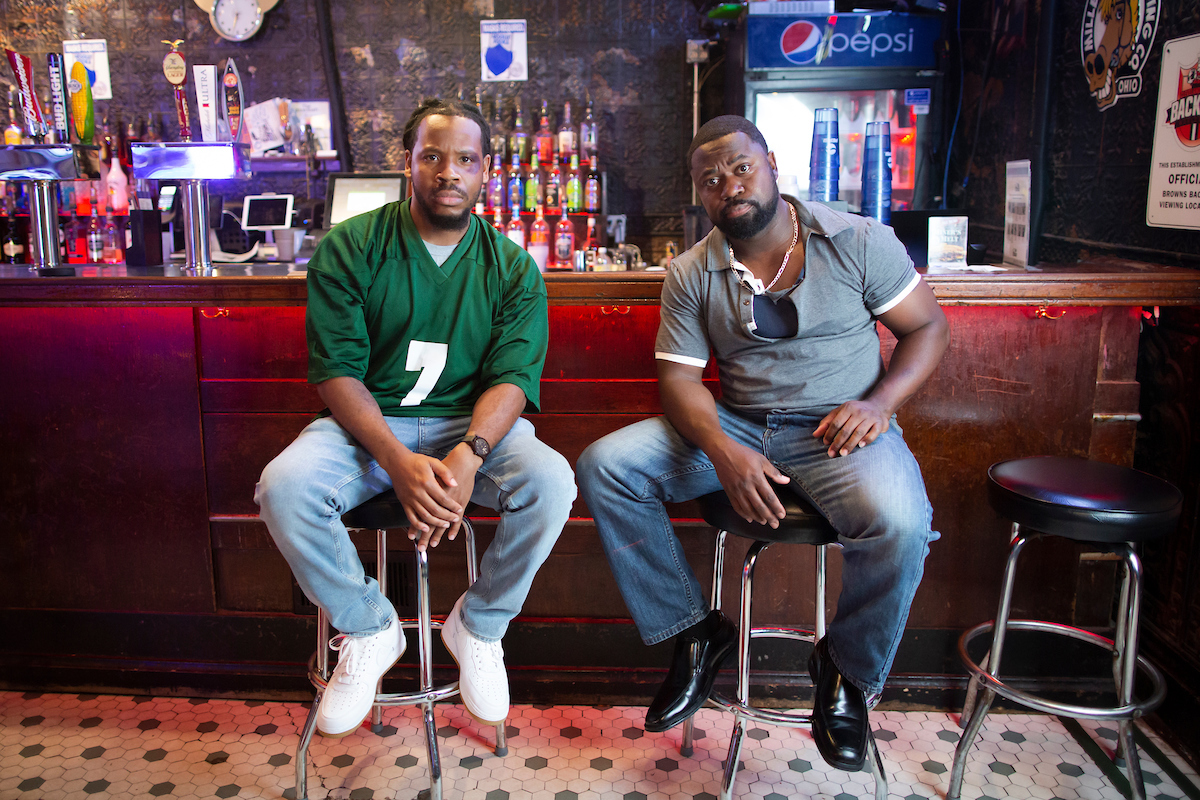
Actors Brandyn Bailey and LeJon Woods.
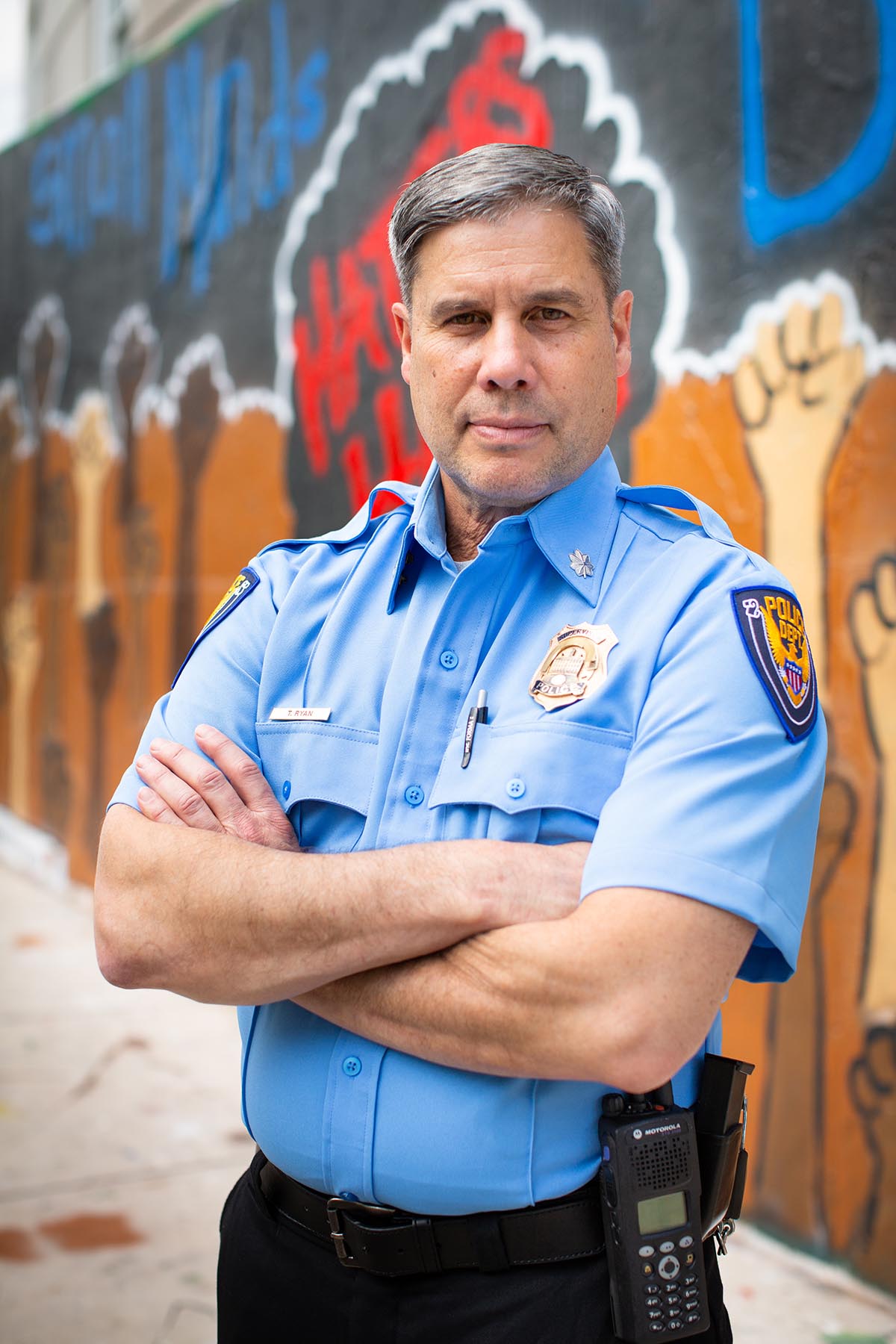
Actor Tim Perez-Ross on set, painted by Denver Bastion. Photos by Megan Westervelt
Award-winning OHIO 360 project
The project received the FBI National Academy Associates Science and Innovation Award for 2023, a significant recognition in law enforcement innovation, indicating the high quality and impact of the work.
"We’ve been working with 360-degree video since 2015,” Bowditch said. “We saw that for the first time, VR was becoming affordable,” down from thousands of dollars for a single headset. The team successfully pitched the idea in 2016 to receive one of four Innovation Strategy Fund awards offered by the Office of Research.
In 2019, discussions about creating an innovative approach to training in crisis situations for law enforcement began and led to the development of the Appalachian Law Enforcement Initiative (ALEI), (now OHIO 360). In addition to Scripps College and Voinovich School faculty and students, the collaborative effort also saw contributions from Tia Jameson, director of Ohio University’s Bobcats Lead Change, Adonis Durado, assistant professor in the School of Visual Communication, and Immersive Audio Specialist Jordan Herron. Funding to produce the law enforcement training scenarios came from a grant awarded through the Voinovich School.
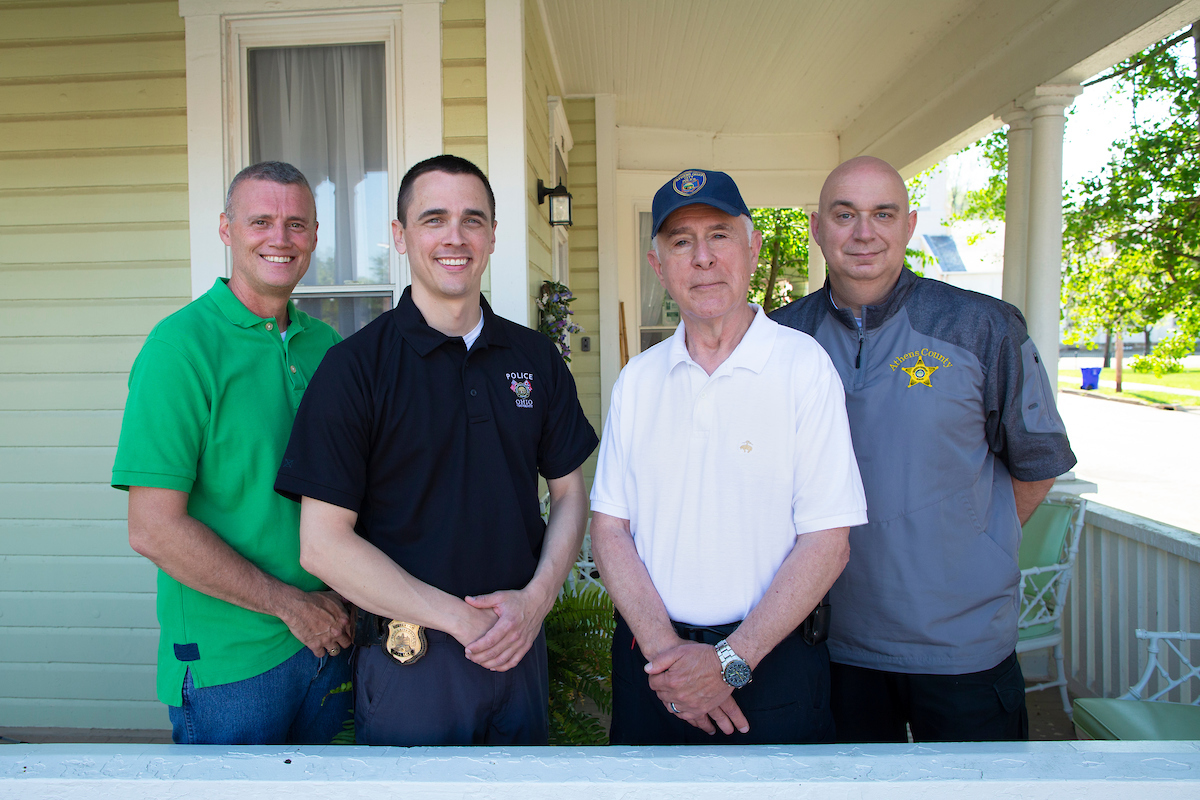
Law enforcement advisors from left: Lieutenant Eric Hoskinson, Lieutenant Tim Ryan, Commander David Malawista, and Captain Aaron Maynard. Photo by Megan Westervelt
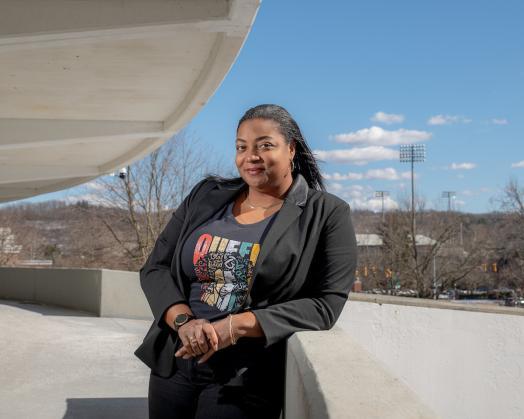
Assistant Athletic Director for Student-Athlete Development & Inclusion Tia Jameson served as a member of the project's development team.
Students play a significant role in the GRID Lab's projects, Bowditch said, contributing to various aspects like graphics, sound, and technical elements. The lab encourages student-led project pitches, fostering a creative and experimental environment. The program also involved collaboration with various county law enforcement agencies, including Athens, Washington, Meigs, Hocking, and Muskingum counties. Ultimately, 200 people from across the University helped bring the training scenarios to life.
These virtual reality experiences have the potential to be transformative for Appalachia, Born said, noting that challenges such as distance, small populations, and tight budgets create limited opportunities for innovative law enforcement training.
Cine-VR helps overcome these challenges, not only from a cost perspective but also because of the ease of the technology's transportation and use, Johnson said. “They’re pretty simple to work,” he said of the headsets used to deliver the scenarios. "They’re user-friendly. Anybody can do it.”
What is Cinematic Virtual Reality?
Cinematic Virtual Reality, or Cine-VR, is a storytelling experience.
The words “virtual reality” conjure a specific scene: You don a pair of VR goggles and enter another world, where you race through city streets, battle aliens, or build rollercoasters. The experience is so immersive, you really feel like you have left the real world. You're less aware of your physical surroundings and fully invested and focused on the goal at hand, whether it’s blowing up a mothership or crossing a finish line.
That entrancing feeling is exactly what makes VR so successful, and Cine-VR takes it to a whole new level, Johnson, a retired Marine colonel, said. “It’s immersive—you're in there. I did two combat tours. We did immersive training, and I would’ve loved to have this [technology]. A lot of that was tactical. This is critical thinking.”
While traditional VR technology has exploded in recent years—mainly through the medium of video games—the technology to create a 360-degree immersive user experience, as happens in Cine-VR, is advancing at an enormous rate. The team uses professional-grade equipment to film, but Bowditch noted 360-degree cameras are “affordable and ubiquitous. They aren't much bigger than a phone now.”
Thanks to this accessibility, OHIO students also benefit. “At the GRID Lab, anyone can pitch a project—and we mean anyone, even [a student] who is starting college in our program on day one,” Bowditch said.
Ohio University offers a three-year MFA program in partnership with the Schools of Emerging Communication Technologies, Media Arts & Studies, and Visual Communication. Williams, director of the MFA program, explained that “our MFA is designed for mid-career professionals, many of whom are returning to learn new digital skills. Being able to jump into a professional project with social impact is a huge opportunity—not only for the graduate students, but also for us at OHIO 360 to add their professional expertise to our production pipeline.”
In addition to the graduate students, the project heavily involves undergraduate students working on bachelor's degree in games and virtual reality development, film, or media arts production.
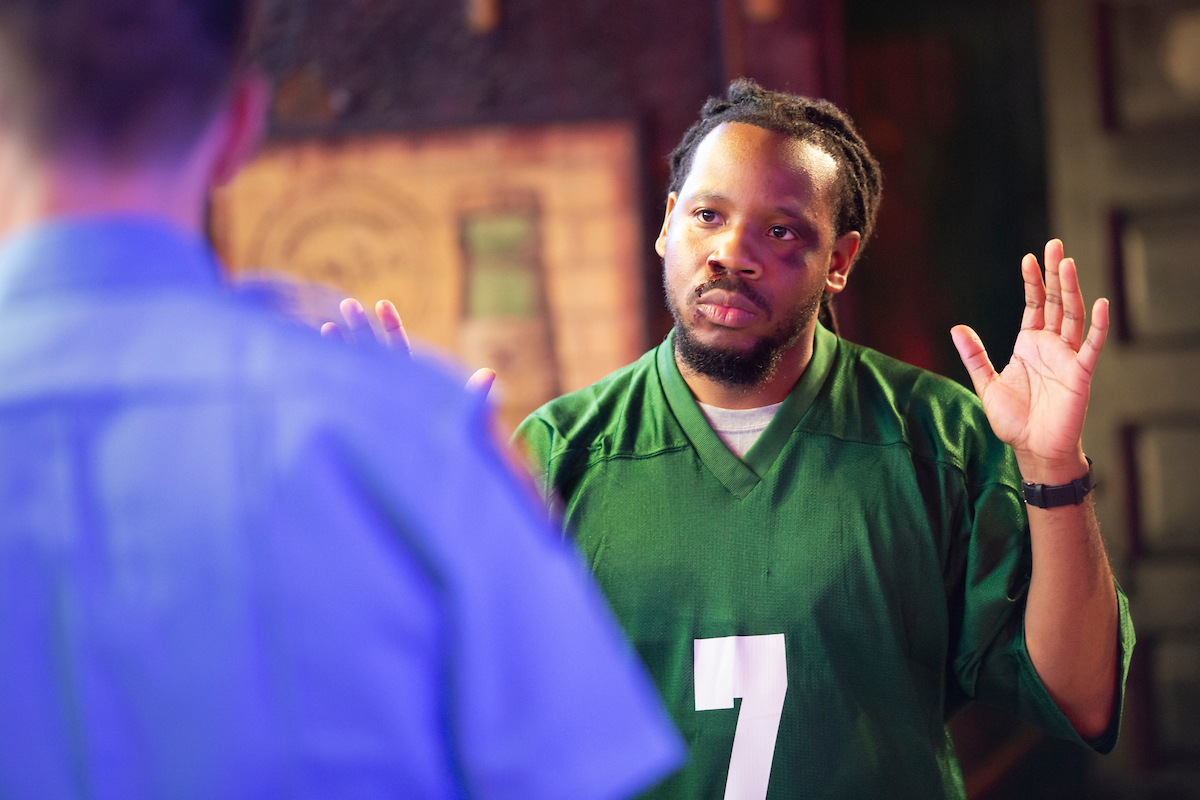
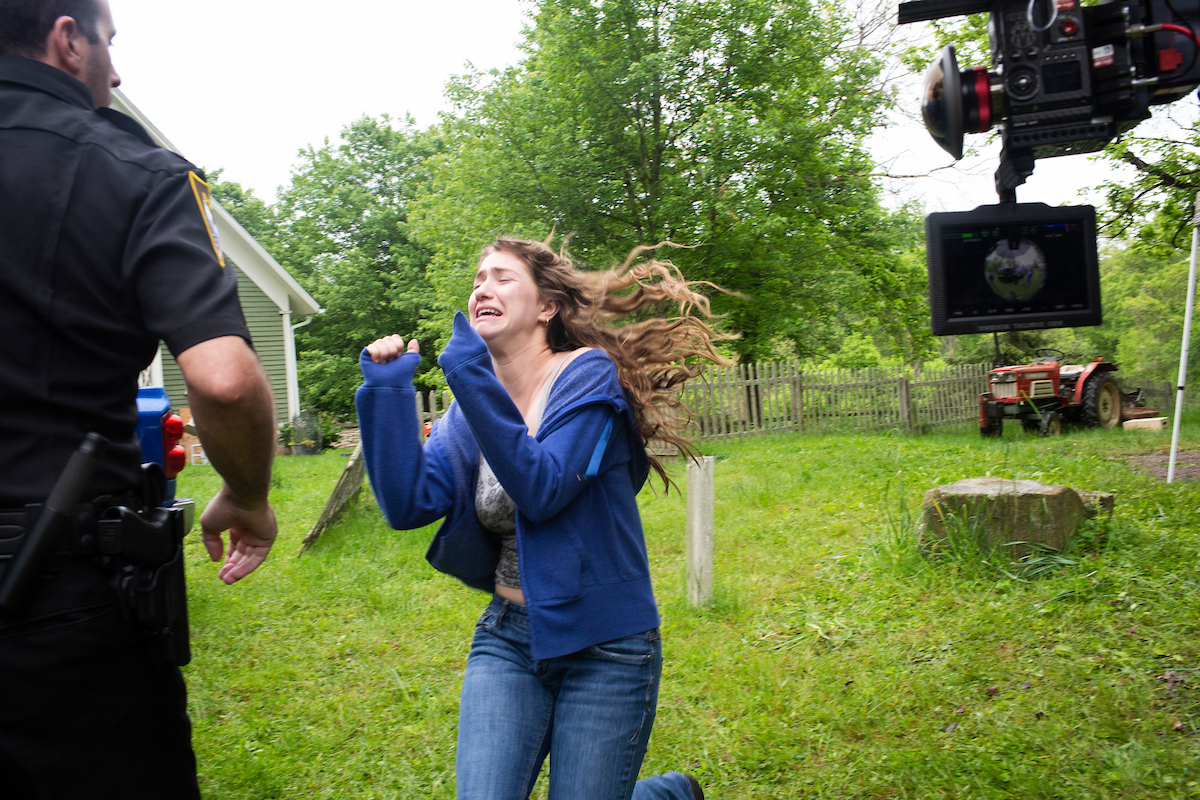
Scenes from the OHIO 360 Project. Photos by Megan Westervelt.
Putting emotional intelligence front and center in officer training
The program aims to develop “soft skills” like listening and neutral responding. Rather than providing tactical training like shooting or making arrests, Johnson says, OHIO 360 focuses on preventing the need for such actions by teaching skills that lead to better law enforcement encounters: “Communication, ability to assess the scene, active listening, de-escalation for this particular [scenario],” he said.
The program was first tested with law enforcement officers in Ohio, thanks to available funding and the need for training resources in the region. More than 80 percent of the officers who took the Cine-VR training preferred it over traditional, classroom-style training, said Born, who previously served as director of the Ohio Department of Public Safety and colonel of the Ohio State Highway Patrol.
The more experiences you have, the safer you become as a police officer.
He compares the training experience to “living in an IMAX movie. It’s not watching it; you’re living in it.”
Born said the Cine-VR trainings create "a perspective you couldn’t see if you hadn’t experienced it. [Cine-VR] provides an alternative to time-intensive, expensive knowledge transfer,” as happens in classroom lecture format. “This is longer-lasting and more impactful,” he said, designed to provide law enforcement with the feeling of the experience that they may not have in any other type of training environment.
“Recent academy grads usually haven’t seen a mental health crisis in a home. The family doesn’t know what to do, so they call 911,” which can lead to unexpected conflict with police, Born said.
Born believes this type of immersive training contributes to better policing outcomes for all. “The more experiences you have, the safer you become as a police officer,” he said.
‘There is no behind the camera’ – tackling Cine-VR’s new storytelling format
Bowditch said four funding awards in 2016 gave the GRID Lab the funding to start working with Cine-VR. “We had six GoPro cameras, and they were put together in a 3D-printed housing. And that housing was screwed on top of an old baseball batter’s helmet that we found at a thrift store."
The lab’s first attempts at Cine-VR were slow going, but illuminated the medium’s possibilities, Bowditch said. “Content that we captured [initially] took almost a month to render. We realized this technology was going to quickly take off, and we wanted to be leaders in this space.”
Claiming that leadership position would take more than a faster rendering speed—Bowditch and Williams would have to expand their understanding of storytelling itself.
“Initially we had the challenge of, ‘OK, so we have this 360-degree filmmaking. Do we approach this like a traditional film? Do we approach this like a video game developer?’ And we found that was a mistake.”
Bowditch said the team learned through experimentation that Cine-VR is an entirely different medium than two-dimensional storytelling.
“I think Eric was really the first to kind of recognize that and come up with this screenplay system to be able to have the full 360 degrees used” throughout the story, Bowditch said.
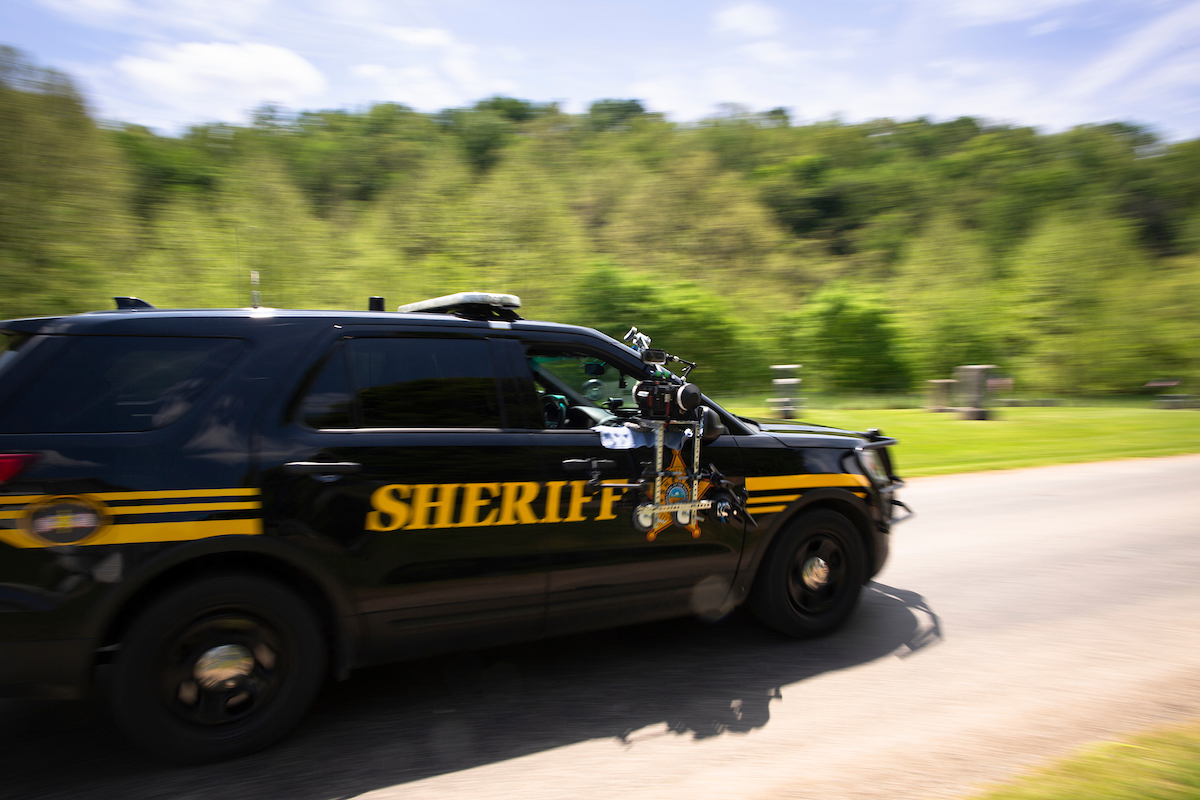
A Cine-VR rig is mounted to traveling sheriff’s vehicle. Photo by Megan Westervelt
For example, one of the early challenges the film crew faced was the basic question of where to position themselves during filming so they wouldn’t be in the scene.
"Traditionally, you would have a camera, it would be facing actors, all of the lighting gear and microphones and stuff would be behind the camera," he said. In Cine-VR production, "There is no behind the camera.
"When we were first doing experiments with this, we would set actors up and then we would all go hide behind like a tree or trash can—like, the crew would hide,” he elaborated. “And always there was someone's arm sticking out, or a leg sticking out, and we'd have to digitally paint that out [in post-production].”
Since then, Bowditch said the team has created ways to shoot “120 degrees at a time. We can shoot the right side, the front side, the backside separately and stitch them all together to be one experience.”
In addition to tackling visual challenges, Bowditch said the audio engineers have learned to place the audio in a 3D space as well. To accomplish this, each actor wears a microphone and is recorded on a separate channel. Those recordings are placed accordingly in post-production by ECT Director Chip Linscott and Herron, whom Bowditch places among the best in the U.S. working with immersive audio.
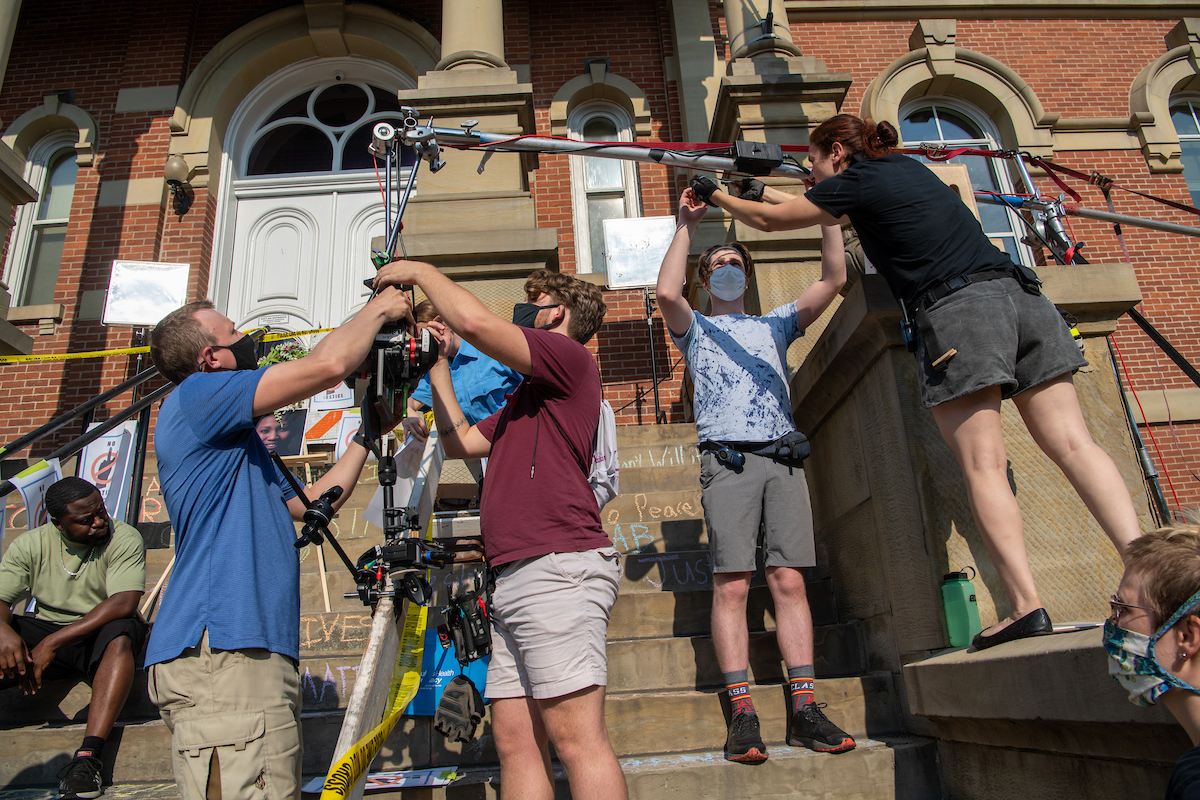
The crew sets up a camera rig in front of the Athens County Courthouse. Photo by Ben Siegel
How Cine-VR will impact job training in healthcare, education, and public service
When most people think of virtual reality, its use in gaming may be the first thing that comes to mind, but its application in real life often remains unexamined.
Inside Higher Ed notes the use of VR technology has expanded in college classroom settings, allowing students to experience and process high-octane situations like public speaking or practicing surgeries.
But Cine-VR's unique presentation format and its implications for job training are only now coming to the surface. Born noted the project garners high interest when presented to job training leaders, in industries from human resources to health care. "Most of the questions we get have been, ‘How quickly can you help us?’,” he said.
Johnson noted the technology is beneficial for all kinds of public service training environments, including school safety, mental health, human resources, and veterans' programs. “I think it gives those in public service—something additional in their toolkit to be better public servants, in whatever capacity they’re serving in,” he said.
What’s really neat is bringing people in and brainstorming what they want [out of a training]... With virtual reality, the sky’s the limit.
“We're open to working with those in the mental health communities—youth, veterans,” Johnson said.
He noted a current benefit of the training is in the creativity inherent to the storytelling process and being able to deliver training that fulfills a specific need. "What’s really neat is bringing people in and brainstorming what they want. What do you want out of the end of this training? With virtual reality, the sky’s the limit.”
To fix its place as a leader in innovative job training approaches, OHIO 360’s creators plan to expand the program beyond Appalachia. It also received attention from Columbus and Louisville police departments and currently collaborates with the Ohio Peace Officers Training Academy.
While potential for the program is vast across various sectors, Johnson noted the program serves as an extender of OHIO’s impact by serving areas within the University as well. "Internally, we’re able to provide support to colleges and schools,” including the Heritage College of Osteopathic Medicine and the College of Health Sciences and Professions.
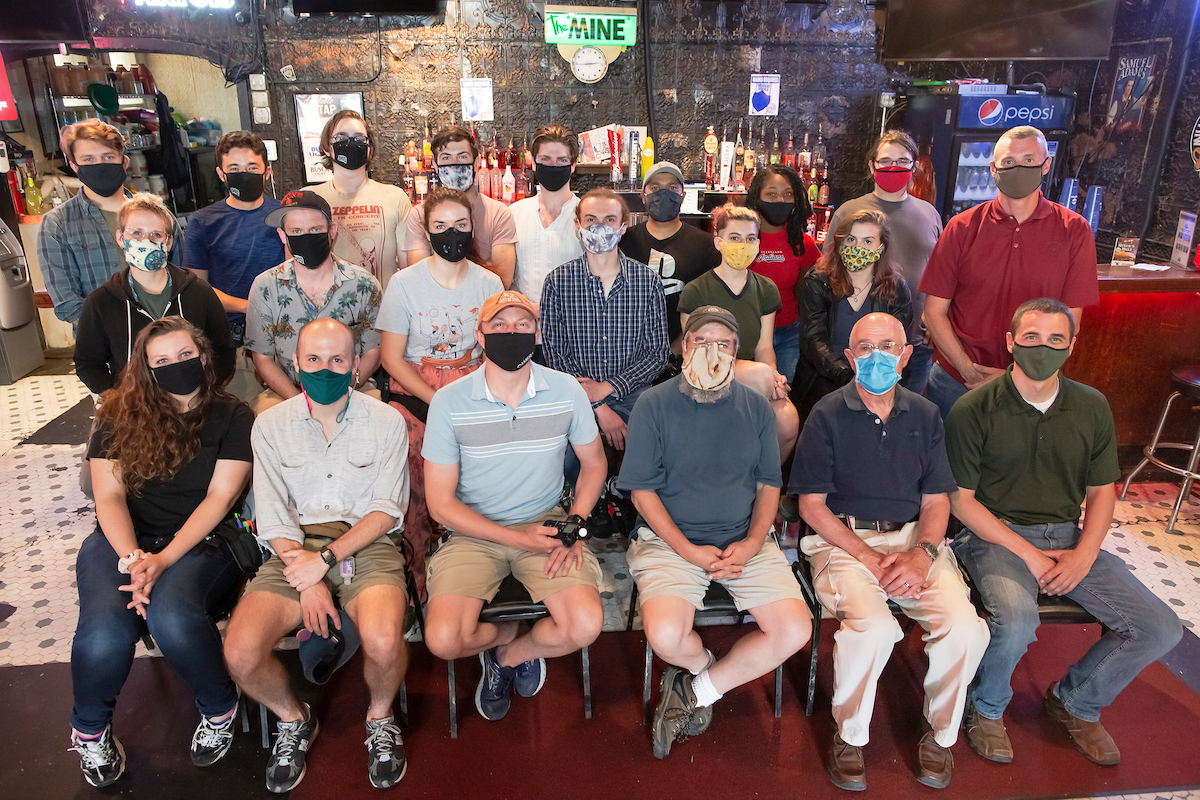
The OHIO 360 project team on location in 2021.
There are plans for additional scenarios authored by Williams, with six new Cine-VR trainings currently in production. Bowditch emphasizes the continual evolution of their approach and the importance of learning from failures and successes.
“Those original cameras, our 3D rig and baseball helmet, have led to millions in grants to do more in this space,” Bowditch said.
Johnson said the team is committed to exploring how Cine-VR can continue to make an impact in job training, for law enforcement and public service in the Appalachian region and beyond. “It's really, truly been a team effort and I'm really proud of what we've done and continue to do,” he said, noting what's exciting to him is the project’s origin story and first beneficiaries: “It was born and bred here in Appalachia.”


